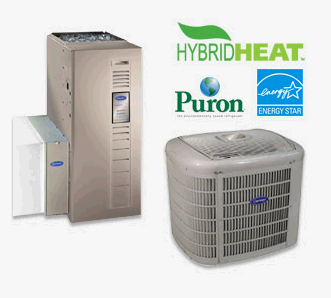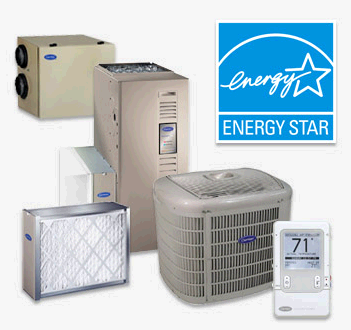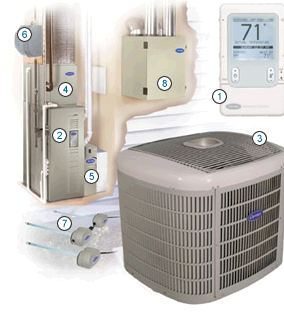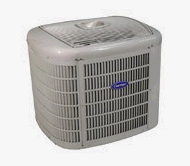Hybrid Heating & Air Conditioning
Oregon ,
 United States
(+1) 503 357-5663
http://www.hybridhc.com
United States
(+1) 503 357-5663
http://www.hybridhc.com
Hybrid Heating & Air Conditioning - Cornelius
Welcome to Hybrid Heating and Air Conditioning. We have been providing exceptional HVAC service in Portland, OR, Beaverton, OR and the surrounding regions of Washington and Oregon for over 29 years, initially under the name McClenny RHC. We focus on the design, installation, service and repair of Carrier high efficiency goods and focus on energy efficiency and green living to benefit the world and lower your energy costs.
We are a well-established business with knowledge and experience in every aspect of residential and commercial heating and air conditioning repair, installation and service. Our technicians have extensive training and experience in heating, air conditioning, commercial refrigeration and indoor air standard. That's why Hybrid Heating and Cooling is a 3 time winner of Carrier's Presidential Award.
| Business Operation Hours | ||
| Monday |
9:00 AM to 5:00 PM |
|
| Tuesday |
9:00 AM to
5:00 PM
| |
| Wednesday |
9:00 AM to 5:00 PM |
|
| Thursday |
9:00 AM to 5:00 PM |
|
| Friday |
9:00 AM to 5:00 PM |
|
| Saturday |
Closed |
|
| Sunday |
Closed |
|
Other HVAC Services : Indoor Air Quality, Heat pump service, Residential zonal heating
Service Type : No,All customers come to the business locationEmergency Services:Services are available 24 hours a day 7 days a week
 HVAC Services
HVAC Services
The environmentally sound refrigerant of the futurePuron Refrigerant.Environmentally sound, chlorine-free Puron® Refrigerant is the refrigerant of the future. And it’s no surprise that Carrier was the only manufacturer to develop indoor cooling products using Puron Refrigerant. As companies worldwide race to upgrade to chlorine-free refrigerants, Carrier offers the experience of having introduced the first air conditioners with an alternative refrigerant in 1996—6 years before other manufacturers caught up.
Today, Carrier has engineered an entire line of heating and cooling products with Puron Refrigerant, available right now to make your home more comfortable.Why Puron Refrigerant.The 1990 Clean Air Act identified refrigerant R-22—the longtime industry standard refrigerant used in most air conditioning and heat pump systems—must be phased out.Carrier’s extensive testing in hundreds of thousands of homes has proven that Puron Refrigerant is superior to R-22 not only in environmental safety, but in performance and energy efficiency. These outstanding results have made Puron Refrigerant the universally accepted, long-term refrigerant for the heating and cooling industry.
Is Puron Refrigerant Right For You.If you are considering upgrading your air conditioner or heat pump, keep in mind that Carrier’s Puron Refrigerant-based products offer several homeowner benefits, including:Energy Efficiency — Most of our Puron Refrigerant air conditioners and heat pumps offer higher efficiency ratings. Puron Refrigerant’s heat-transfer properties lend themselves to higher-efficiency performance.Future Cost Of Service Savings — Because of U.S. government restrictions on future production, refrigerants with ozone-harming CFCs, the refrigerant used in most of today’s heat pumps and air conditioners, will become harder to find and, eventually, more expensive. Upgrading to Puron Refrigerant now can help you avoid the potential rising cost of servicing most of today’s air conditioners and heat pumps.
Reliability — Carrier air conditioners and heat pumps with Puron Refrigerant have become the most reliable products in our entire line.Quiet Operation — Many of the air conditioners and heat pumps with Puron Refrigerant also offer Carrier’s Silencer System technology for quieter operation.For example, milder regions such as the southern U.S. and Pacific coast of the USA need far less energy for space conditioning than New York City or Chicago. On the other hand, air conditioning energy use can be quite high in hot-arid regions (Southwest) and hot-humid zones (Southeast) In milder climates such as San Diego, lighting energy may easily consume up to 40% of total energy. Certain.
appliances such as a waterbed, hot tub, or pre-1990 refrigerator use significant amounts of electricity. However, recent trends in home entertainment equipment can make a large difference in household energy use. For instance a 50" LCD television (average on-time= 6 hours a day) may draw 300 Watts less than a similarly sized plasma system. In most residences no single appliance dominates, and any conservation efforts must be directed to numerous areas in order to achieve substantial energy savings. However, Ground and Water Source Heat Pump systems are the more energy efficient, environmentally clean, and cost-effective space conditioning systems available (Environmental Protection Agency), and can achieve reductions in energy consumptions of up to 69%.
Standby power used by consumer electronics and appliances while they are turned off accounts for an estimated 5 to 10% of household electricity consumption, adding an estimated $3 billion to annual energy costs in the USA. "In the average home, 75% of the electricity used to power home electronics is consumed while the products are turned off."The efficiency of furnaces and air conditioners has increased steadily since the energy crises of the 1970s.
The 1987 National Appliance Energy Conservation Act authorized the Department of Energy to set minimum efficiency standards for space conditioning equipment and other appliances each year, based on what is "technologically feasible and economically justified". Beyond these minimum standards, the Environmental Protection Agency awards the Energy Star designation to appliances that exceed industry efficiency averages by an EPA-specified percentage. Despite technological improvements, many American lifestyle changes have put higher demands on heating and cooling resources. The average size of homes built in the United States has increased significantly, from 1,500 sq ft (140 m) in 1970 to 2,300 sq ft (210 m) in 2005.
The single-person household has become more common, as has central air conditioning: 23% of households had central air conditioning in 1978, that figure rose to 55% by 2001. As furnace efficiency gets higher, there is limited room for improvement--efficiencies above 85% are now common. However, improving the building envelope through better or more insulation, advanced windows, etc., can allow larger improvements. The passive house approach produces superinsulated buildings that approach zero net energy consumption. Improving the building envelope can also be cheaper than replacing a furnace or air conditioner. Even lower cost improvements include weatherization, which is frequently subsidized by utilities or state/federal tax credits, as are programmable thermostats. Consumers have also been urged to adopt a wider indoor temperature range (e.g. 65 F (18 C) in the winter, 80 F (27 C) in the summer).
One underutilized, but potentially very powerful means to reduce household energy consumption is to provide real-time feedback to homeowners so they can effectively alter their energy using behavior. Recently, low cost energy feedback displays, such as The Energy Detective or wattson, have become available. A study of a similar device deployed in 500 Ontario homes by Hydro One showed an average 6.5% drop in total electricity use when compared with a similarly sized control group. ---TAKEN FROM POWERSET!
 Additional Information
Additional Information
Whether you’re purchasing a new home or upgrading your heating system, high efficiency heating equipment is a smart choice. Look for Energy Star appliances, which meet rigorous efficiency standards set by the Environmental Protection Agency and the U.S. Department of Energy. Another excellent source of information is the CEE website (Consortium for Energy Efficiency). The CEE is a non-profit organization dedicated to encouraging businesses and industry leaders to produce and sell high efficiency appliances, and the website lists participating members. These appliances may cost more initially, but they will bring returns through lowered utility bills.
If you’re looking for a heat pump, also check out the SEER rating, which stands for Seasonal Energy Efficiency Ratio. This number is calculated by dividing the number of BTUs of heat transference by the total watt-hours of energy use. One BTU (British Thermal Unit) equals the amount of energy required to raise one pound of water one degree Fahrenheit – roughly the amount of energy created by a lit birthday candle; watt-hours measure electricity. The higher the SEER number, the more efficient the heat pump. Just as important as the efficiency rating of your equipment is that it’s properly sized and installed, which is why it’s imperative that a certified technician install and maintain your heating system. Besides saving you money, an energy efficient heating system releases less pollution and benefits the environment – it’s a smart, progressive investment.
 Languages Spoken
Languages Spoken
English
 Payment Options
Payment Options
 Visa
Visa Master Card
Master Card Cash
Cash Check
Check











Write a review for Hybrid Heating & Air Conditioning
* Review Title
* Review